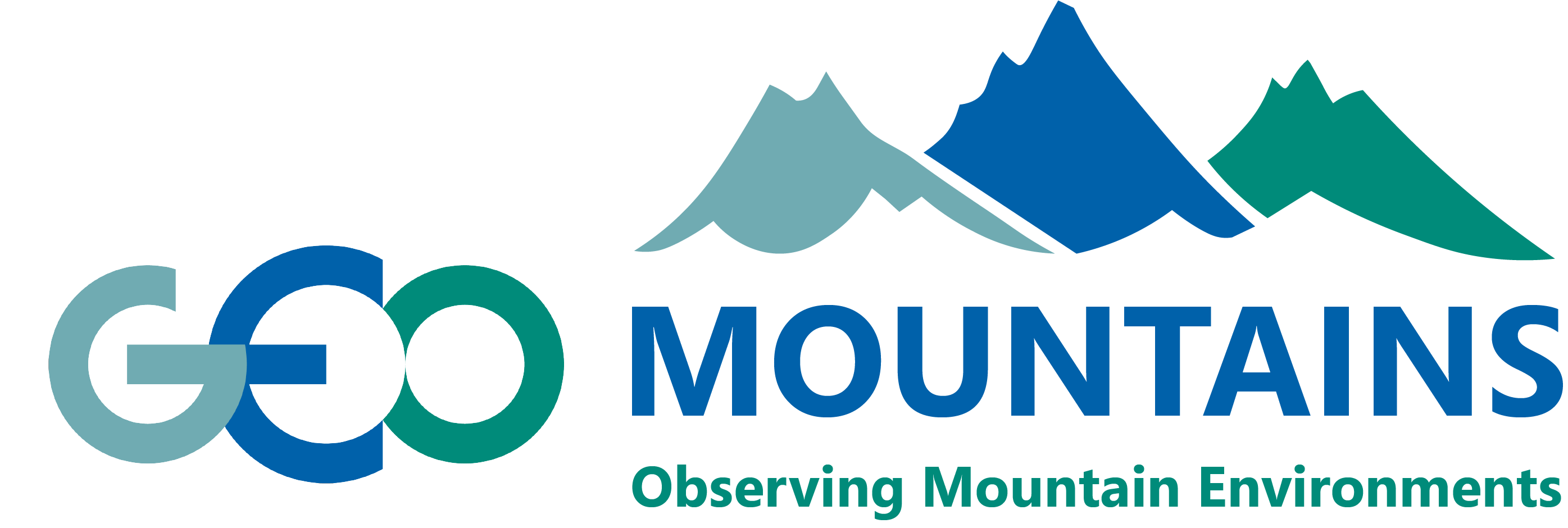

Global Network for Observations and Information in Mountain Environments
Challenge
Mountains have high bio- and geodiversity, are a key component of the Earth’s system, and provide essential resources and services to people living in and around mountains and downstream areas. However, with the accelerating pace of change, e.g., climate change, impacts from these changes are compounding and/or increasing and having serious consequences for both people and ecosystems. Adapting to and mitigating these impacts is imperative for safeguarding human well-being, functional ecosystems, and water and energy security. Access to and use of reliable data and information are fundamental for supporting monitoring efforts, which remain fragmented and deficient in many mountain regions.
Solution
Enhancing the quality, range, and availability of data and information at the global and regional scales continues to be a key objective, but it is insufficient given the scale of the challenges faced. Previous work through GEO Mountains and partners identified user needs for integrating data and knowledge concerning biophysical changes with information on socioeconomic and human dimensions of change. This integration could not only support systemic predictive capacities but also help substantiate policies and practices, including governance and financial capacities to sustain well-coordinated, long-term observations and formats that are accessible and fit for multiple applications.
Intended Socioeconomic and Environmental Impact
Generally, GEO Mountains seeks to: (1) strengthen the availability and use of observation data and knowledge products on coupled biophysical and socioeconomic aspects that affect mountains; (2) improve monitoring and modeling capacities and knowledge on strategies that address key impacts; and (3) transfer that knowledge through science-policy-practice platforms to inform decision-making in national, regional, and global policy processes. In pursuing these goals, GEO Mountains makes concrete contributions towards closing observation gaps in mountains, which, in turn, helps reduce losses and damages from disasters, support the conservation and protection of ecosystems, and safeguard key resources, such as water.
Objectives for 2025–2030
In this period, GEO Mountains will continue connecting and supporting a worldwide community network of data and information providers and users working in and for mountain regions, and will take concerted steps towards fulfilling a greater “research-to-operations” function. Building on its legacy and growing community, it will establish a functional platform and network that not only provides access to relevant data, models, and information on key drivers and processes of change in mountains but also enables the capabilities needed to generate outputs that respond to knowledge needs on challenges and opportunities relevant to mountains. These objectives are concurrent with activities planned between 2025 and 2027, for which funding is secured through a contribution from the SDC to the MRI for coordination purposes.
Ongoing and forthcoming activities include advancing and coordinating the processing and population of inventories and databases with information for subsequent analyses, with particular emphasis on generating outputs that integrate data and information across natural and human system domains. Other tasks include facilitating processes for the co-production of knowledge in the form of surveys, focus groups, expert elicitation, and workshops, among others, to ensure the relevance and improvement of the platform, including inputs on its utility from a user perspective. Synergies and connections with other relevant and well-established networks, such as ICOS, LifeWatch, eLTER, and iLTER, among others, are a key part of improving this platform.
A sustainability strategy is also part of what GEO Mountains will focus on developing in this period, particularly in sustaining the access and longevity of data and information gathered, resource mobilization, defining governance options, and evolving the Initiative post-2027.
GEO Mountains will also seek to contribute to the MRI’s key objectives in 2023–2026, specifically in helping to consolidate the state of the art based on 25 years of scientific advances, research, syntheses, data, and information fostered via the MRI.
How We Work
The MRI and CNR co-lead the Initiative. As a Flagship Activity of the MRI, the Initiative aligns with its mission and vision and responds to its programmatic and strategic priorities on long-term mountain data and monitoring. MRI staff provide secretariat support and coordination. A core group of partners provides ad hoc strategic and programmatic advice. A website and monthly news mailout are used to communicate with our 743 members (as of 13 November 2024). Biannual General Meetings are convened to interactively connect this community, share progress, and exchange information. Defining a governance structure for a post-2025 phase will be a focus in 2025.
Donors
Partners
GEO Members
GEO Participating Organizations
GEO Associates
Non-affiliated
Points of Contact


